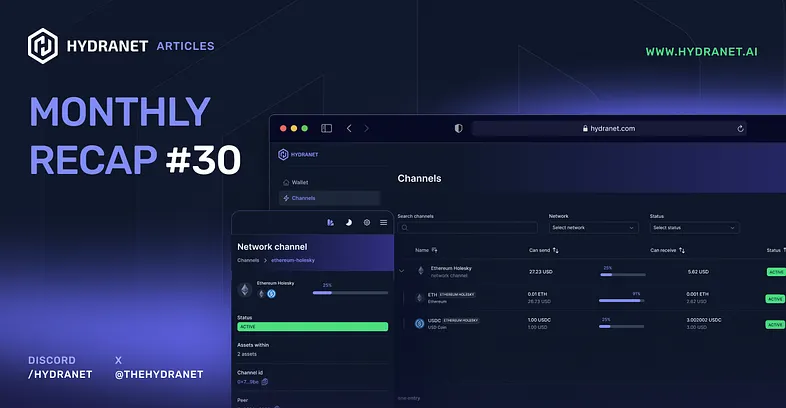Hydranet Monthly Recap #30 — November 2024

The month of November is all about our latest achievement(s), the first of many successful swaps on our web DEX. Our team managed to achieve the first successful off-chain swap already in October, although it was “only” through the backend. Since then we have worked diligently with integrating the backend with the frontend to create the seamless product we have envisioned. As first movers in this space, encountering and resolving issues is part of the journey. This month has been dedicated to refining our platform, stabilizing its features, and preparing for Alpha testing. Here’s a summary of what November brought.
Backend and orderbook updates
Much of the functionality we call Hydranet lies in the backend of our platform, the part users rarely see. In testing the swap function and troubleshooting issues that have aroused during development, the backend of Hydranet saw several key updates implemented this month:
- Channel rental manager: Problems with rented channels failing to close properly. This is crucial, especially for the SimpleSwap feature which is supposed to facilitate a fast trade with minimal channel rental time.
- Swap Reliability: Issues with maximum payment amounts were resolved, and a novel approach was introduced for processing Lithium payments sequentially instead of in parallel. While this fix ensures stability, work is ongoing to enable simultaneous parallel payments for a more efficient swap experience in the future.
- Channel Registry and Capacity Validation: We completed work on the channel registry and started implementing channel capacity validation functions. These features will ensure that the orderbook will only accept orders for which the users have sufficient state channel liquidity, both inbound (receive) and outbound (send), to avoid disruptions from invalid swap transactions.
- API Upgrades: To improve transaction tracking, we migrated from the Covalent API to the more robust Etherscan API that fits our needs better at this moment.
The order book, closely tied to the backend, also underwent several improvements throughout the month of November, bringing us closer to a functional trading platform. Debugging efforts for liquidity movement functionality were completed, and improvements to the order matching engine were rolled out.
Frontend advancements
This month, the frontend of Hydranet also saw a few updates, addressing user experience issues on the SimpleSwap page and adding swap information to the Transactions page. The major breakthrough however is the integration of the SimpleSwap frontend and backend, allowing for swaps directly from the SimpleSwap interface. This integration has been thoroughly tested and debugged by our developers throughout the month of November, taking it closer toward the stage of Alpha testnet.
First swap!
In celebration of our first successful swap, we published an article detailing our unique orderbook! Hydranet isn’t just another DEX, it’s an off-chain DEX offering endless possibilities. Unlike traditional DEXs or centralized exchanges (CEXs) that rely solely on automated market makers (AMMs) or limit order books, Hydranet combines the strengths of both in a hybrid model. At its core, Hydranet operates like an AMM, enabling users to create liquidity pools with defined price ranges. Adjustments to these pools can be made instantly and without network fees, as all trades occur off-chain. For users seeking precision, concentrated liquidity at specific price points emulates traditional limit orders. This hybrid approach pools liquidity into a unified resource, accessible via both a traditional DEX interface (SimpleSwap) and an order book layout. The result? A seamless bridge between decentralized and centralized exchanges, offering the flexibility of AMMs without gas fees and with the precision of order books.
Getting closer to Alpha
Excitement is building as we approach the Alpha release of Hydranet’s web wallet and DEX. Testers can look forward to exploring the following features on Day 1 of testing:
- Cross-Chain Swaps: Seamlessly swap Bitcoin on the Lightning Network with EVM assets on the Lithium Network.
- On-chain and Off-chain Transactions: Send, receive, and transfer BTC and EVM both on- and off-chain.
- Channel Rental Service: Rent state channel liquidity to facilitate receiving payments off-chain.
- Transaction History: Comprehensive records of both on-chain and off-chain transactions.
Future Alpha updates will include a channel backup service for enhanced security and a liquidity tab for users to contribute to the orderbook without navigating an orderbook interface.
If you haven’t signed up for the Alpha test phase yet, this is your chance to be part of Hydranet’s pioneering journey. Sign up here.